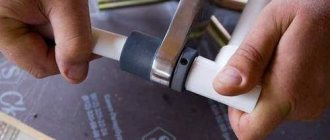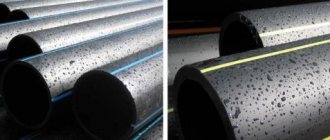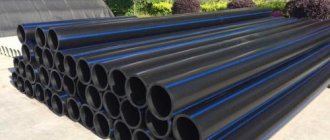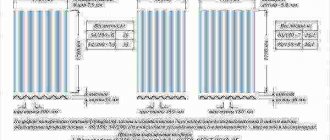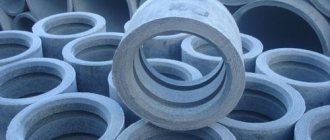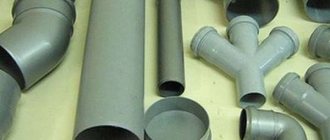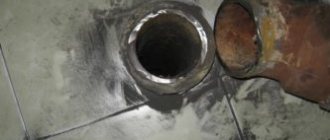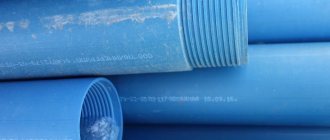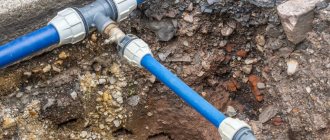Hello readers!
In this article I want to talk about how to properly cut plastic pipes. What tool is better and more convenient to do this? Metal-plastic pipes are capturing an increasingly larger segment of the plumbing market, so the issue of their maintenance is becoming more pressing. There is an opinion that if it is necessary to replace such pipes, the entire pipeline must be replaced. But this opinion is wrong.
The products are easy to cut and replace in parts without harming the overall plumbing or heating system. Below we discuss how to properly cut metal-plastic pipes.
Cutting methods
There are several basic cutting methods, which directly depend on the tool used. First of all, you can cut products:
- Knife for efficient cutting of metal-plastic pipes. In this case, the knife should be self-sharpening.
- Hacksaw for metal. The simplest method, which, however, will require a lot of effort and time from the performer. In addition, the edges may turn out torn.
- Scissors.
- Pipe cutter.
When using some tools, the edges of the cut are quite uneven, and particles of material can subsequently cause clogging. The best way is to use special scissors that cut evenly without leaving torn edges. These scissors can cut objects with a diameter of up to 40 mm.
Important! In this case, you don’t have to put in any special effort, since the tool is specially designed for such work and has special blades. These blades easily cut through plastic pipes anywhere.
For larger diameter products, it is better to choose a pipe cutter. Pipe cutters come in telescopic and ratchet types. The first type is based on the operation of a special roller that rolls along the entire circumference. The second type is more similar to scissors, as it uses a lever system with two handles.
Choosing a pipe cutter – mechanical vs electric
In everyday life, for one-time work, it is recommended to use hand-held cutting tools. It costs less than an electric one and is easier to use.
If you need to make several cuts to install a water supply in a private house or apartment in the area from the riser to some plumbing, then this is simply the ideal choice. However, with large volumes of work, cutting pipes with it will take a lot of effort and time.
Electrical equipment will cost more than its mechanical counterpart. But it greatly facilitates and speeds up the process of cutting polypropylene pipes. The result is smoother edges. In this case, you do not have to exert force to press the handle; you just need to hold the electric pipe cutter exactly along the cutting line. Errors are practically eliminated.
Every power tool requires power to operate. If there are problems with this (electricity has not yet been connected to the newly built house or accidents constantly occur), then it is better to prefer a manual pipe cutter. You will have to work hard and put in effort, but the installation of water supply and sewerage will be completed on time without delays.
The manual pipe cutter has compact dimensions. It is often simply impossible to bring a bulky electrical analogue to an already installed pipeline in order to make a tie-in into it. But with hand scissors you can make such a cut without any problems.
An alternative to both of these pipe cutter options is an electric one with a removable battery. Such a tool weighs only 1.5–2 kg. The electric drive makes the cutting process easier, but you don’t have to look for an outlet to connect such “scissors.” The battery usually lasts for a couple of hundred cuts, which is quite enough for a full day of work.
How to cut metal-plastic pipes
Metal-plastic pipes have a number of advantages over their competitors. They are much lighter than metal and much more resistant to oxidation than copper. They are easy to replace and easy to shape into the desired shape.
You can create a pipeline of any shape. Well, the main advantage is the cost. It is much lower than that of copper pipes. And the quality is approximately at the same level.
During operation, it may be necessary to cut pipes. For this, a special tool is used that is designed to work with such material.
To increase the effectiveness of the procedure, it is recommended to properly prepare the pipe and tools before work. Let's look at the main features of metal-plastic pipes and how to cut them.
Preparing the pipe and necessary tools
The tools used are the cutting device itself, measuring tapes, adjustable wrenches, seals and some other things. All this must be in an accessible place at the time of work.
Sometimes it is necessary to scrape the outside of the reinforced coating to make the cutting process easier in the next step. For stripping, a coupling with blades is used, which allows you to get a perfectly even cut and get rid of the polymer layer. This is necessary for welding work, which will most likely be carried out during pipeline installation.
Important! When working, it is necessary to cut off exactly as much material as is needed to attach the fitting for metal-plastic products.
Guillotine Rothenberger ROCUT XL 125
The cutter is manufactured by the same manufacturer as the previous model. Suitable for use in any part of the pipeline. The blade has a V-shape, which facilitates the process of cutting workpieces. It is made of alloy steel. The cutting edge angle is optimized, making the tool even easier to use.
The lower clamping device of the guillotine cutter is convenient. It folds completely. Therefore, you can use this pipe cutter even in cramped trench conditions. The model is suitable for cutting pipes with a diameter of up to one hundred and twenty-five millimeters. Can be used to work with workpieces made of all types of plastic.
The tool has proven itself well. Among models of a similar type, it stands out due to its versatility and ease of use. Blade replacement is quick and efficient. If you decide to opt for a guillotine-type cutter, this option will be the most optimal.
Tools for cutting metal-plastic pipes
The following tools will be useful in the pipe cutting process:
It is important for the master to determine in advance what he will use to cut metal-plastic pipes. The most important tool on the list is scissors. Everything else is necessary for special preparatory work.
There is no need to apply much force during the cutting process. You just need to fully control every movement. If you do not pay due attention to control, you can easily cut off the excess part.
If during the cutting process it is necessary to bend the product, it is not recommended to do this by hand. This can easily damage the aluminum layer that is inside. It is better to take a professional pipe bender and perform the operation with its help.
Using the wrong tools on one area can affect the entire network, resulting in high repair costs.
Important! Special scissors are usually found in the welding kit. But they can be purchased separately. The price of this tool is not so high as to save on it.
Before you start cutting directly, you need to very clearly measure the part where the unit will be divided. To do this, use a tape measure or ruler, as well as a bright marker. A faded pencil may simply not be visible, especially if there is not enough lighting in the room. The mark can be made with a knife, leaving a scratch.
During operation, pieces of plastic and aluminum may fly in different directions. Therefore, it is necessary to use protective equipment in the form of glasses and special clothing.
Roller cutter
Before fixing the pipeline to the walls and installing its individual sections into a single system, you need to trim the workpieces to the appropriate size.
Use the roller cutter carefully. Consider some features of using a pipe cutter:
- the workpiece must be rolled between wide rollers and the cutting part;
- the cut is smooth, so when installing pipes there is no damage to the rubber sealing ring;
- The procedure for cutting workpieces using this cutter takes quite a lot of time.
A roller cutter is necessary when cutting large size sewer pipes. The tool is used when working with pipes with a diameter from 50 to 110 mm.
Cutting is performed in a certain sequence. Immediately you need to mark the place of the cut. Unscrew the screw and move the bracket to the cutting area. To secure the clamp, you need to slowly rotate the screw. However, you should not put in excessive effort. Otherwise, the pipe may be damaged. Next, rotate the cutter around the workpiece. After a few minutes, parts of the product will separate.
Cutting technique
Self-cutting can be carried out with products with a diameter of 5 to 30 cm. So, if the product does not fall within these boundaries, it is best to turn to professionals.
When carrying out any such manipulations, it is important to remember the basic rules:
- Metal-plastic products are very sensitive to temperature, so some problems may arise in hot or cold weather. The material shrinks and expands easily, making it difficult to determine the true dimensions.
- Metal-plastic, like polypropylene pipes, can be cut with any available means. But in order to avoid various negative consequences, it is best to do this with special tools.
- An excellent tool is a special self-sharpening knife. But if you plan to carry out work to replace one section with another, it is better to abandon the tool in favor of scissors.
- The material is quite fragile. Applying too much force can result in cracks or specific deformations. The permissible load can be seen in the product passport, which was issued at the time of installation of the water supply system.
- The type of cutting directly depends on the proportion of metal and plastic in the product. If there is more metal, then when cutting there should be as little friction as possible. Otherwise, a large proportion of plastic means a higher intensity of work with high friction.
- Before starting work, you must make sure that there is no water or gas flowing through the pipe. You need to turn off all the taps and wait a little.
- After completing the work, you need to thoroughly clean the inside of any debris that could lead to blockages or break specialized equipment.
The use of electronic cutting tools is not considered reasonable, since the specific material is not designed for this. You can do it manually.
Source: znatoktepla.ru
Milwaukee C12 PPC-0 Cordless Cutter
The model is produced by the American company Milwaukee Electric Tool, specializing in the manufacture of professional tools. The cutter is suitable for working with pipes with a diameter of up to fifty millimeters. When cutting workpieces, strong pressure is created. Therefore, working with the tool is easy. It takes three seconds to cut a PVC pipe of the maximum diameter allowed for this pipe cutter. The gear housing and gears are made of durable metal. Due to this, maximum torque is achieved.
The cutting speed can be adjusted. The device is equipped with a good battery. One charge is enough to make two hundred cuts. The battery is reliable. It is characterized by a long service life. For small diameter pipes, this tool will be the best choice. If you do not want to buy a pipe cutter for each size of workpiece, stop choosing more universal models.
Watch the video:
Source: trubtraid.ru
Briefly about the drainage system
The sewerage system is a description of all components and the principle of operation of the system as a whole and for individual units. Subdivided:
- Internal – located in the building.
- External - laid outside buildings.
Internal
Internal sewage system:
- Plumbing fixtures (sources of dirty water): toilet, bidet, washbasin (kitchen sink), bath (shower), washing machine and dishwasher.
- Siphons and connection elements (transition couplings).
- Outlet pipes Ø 30–50mm. For toilet 100mm.
- Transition elements: fittings and couplings, check valve, revision.
- The main riser is an element that collects wastewater from all sources into one sewer pipe. The collector diameter should not be less than 100mm.
Installation of a sewage system indoors is regulated by regulatory documents: SNiP (Sanitary Norms and Rules) 3.05.01–85 “Internal sanitary systems.”
Outdoor
The external system includes:
- Sewage line made of pipes Ø 100–200 mm (for individual housing).
- Overflow (inspection) wells.
- Couplings, fittings.
- Wastewater receiver (cesspool, septic tank, biotreatment station).
The installation of sewerage outside the building is regulated by SNiP 2.04.03–85 “Sewerage. External networks and structures."
Installation
The installation of internal sewerage and external mains is in many ways similar. The difference is in the materials used. For internal sewer systems, gray-painted collectors are used. The outer ones have an orange tint. This is due to the difference in external loads:
- Products located indoors are subject to their own weight and, periodically, the load from flowing liquid. Thermal heating is added to 60–90°C with a parallel chemical attack from the components of the effluent.
- Parts located outside the building are subject to:
- pressure from the mass of the covering soil;
- exposure to the weight of passing vehicles;
- experience forces from buildings located above;
- exposed to external temperature changes, from negative to positive.
Hence, the installation of internal sewerage is carried out with a predominance of polymer materials:
- PVC (polyvinyl chloride). More precisely, unplasticized PVC (PVC-U).
- HDPE (low density polyethylene).
- PPR (polypropylene).
The most in demand are PVC products. Installation of internal collectors is carried out by joining the narrowed part of the pipe and the expanded part (socket). Additional elements are used - fittings (reducing couplings, tees, elbows with an angle of 45° and 90°, bends).
Installation of sewer pipes is carried out with obligatory observance of the angles of inclination:
- For a Ø 50mm collector, the slope will be 2–3 cm per linear meter of length.
- For a product Ø 100mm, about 1–2 cm per 1 meter.
During installation or repair work, there is a need to cut a plastic part. Polymers do not have high hardness and strength compared to metal products. Therefore, they can be processed with most metalworking and mechanical tools. It is possible to cut a plastic pipe using:
- hacksaws for metal or with fine hardened teeth;
- triangular file;
- jigsaw (for diameters not exceeding 50mm);
- circular or reciprocating saw;
- grinder and other tools.
Installation of sewerage systems is carried out according to the rules based on the requirements of SP 30.13330.2012. In addition to observing the slopes, it is necessary to correctly distribute the points of attachment and connection. If technically possible, it is recommended to carry out hidden wiring.
Installation of sewer pipes indoors begins:
- from drawing up a work plan;
- execution of a sketch or drawing;
- determining the required dimensions of the collector;
- procurement of the necessary material;
- preparing a tool with which you can cut a plastic part.
At the end of the installation stage, the internal sewage system is checked visually. Next, it is necessary to flush the system with water in order to identify possible product defects or leaks.
Red PVC sewer pipe: what is it and where is it used
The sewer system can be installed using pipes made of various materials. Steel, asbestos-cement, and ceramic channels have been replaced by plastic channels - easier to install and operate. There are internal and external sewerage networks. Since they operate under different conditions, the requirements for structural elements are different. PVC products are suitable for external systems, namely red sewer pipes.
READ How to cut laminate flooring when laying it on the floor
Red-colored sewer pipes are used for the installation of external and internal drainage networks
Outdoor system installation
Installation of sewerage from plastic pipes outside the building is carried out, in most cases, inside an earthen trench. This is due to:
- the need to protect the plastic sewer structure from exposure to negative temperatures;
- rational use of the surface of the earthen area; protection from possible mechanical damage.
Installation of sewerage systems outside the trench is carried out:
- in the presence of high groundwater levels (wetlands);
- rocky or frozen soil (permafrost);
- other technical limitations.
Installation of sewer pipes on the site is carried out mainly in the warm season. This makes it easier to install sewer pipes - a more comfortable climate and the presence of thawed ground.
Products for external use - red pipes, are made of polymers. Parts can be cut or trimmed in the same ways as for structures for internal use. Installation of sewer plastic pipes is carried out on our own or with the involvement of a third party.
The method - how to cut the parts when installing sewer pipes indoors or outside the building, it is advisable to think about it in advance, before starting work. Otherwise, you may not have the necessary device or tool at hand, which will significantly complicate the process of installing the highway.
Source: hemkor.ru
Fixing the pipeline
When constructing engineering structures, special fastenings are used to provide support for the sewerage system along the entire length of the system. They come in different types: stands, clamps, holders, clips. Such products are made from metal, plastic and glass. They are installed with a certain step, and such fastenings should be located at the connecting points of the pipeline sections.
Metal holders provide a strong, secure fit. Thanks to such fastenings of sewer lines, the likelihood of a leak is minimal, because the pipeline does not sag under its own weight. It is advisable to use plastic holders in cases where there is a need to install a floating sewage system. In small rooms, holders are not always used, due to the short length of the walls.
Hacksaw
The first is a hacksaw. When they come to some object with a pipe and a hacksaw, they do this.
The result is straight edges. And when a pipe is inserted into a pipe, this rubber band is bitten on the edge, so plumbers have to do an additional operation, namely chamfering. This is done either with a knife, respectively, or the pipe simply rubs against the concrete, and a chamfer is obtained.
Why is this method good? It's a small instrument, relatively small. Although we see that ours is quite large and long, and without protection it cannot be moved. Well, if you want to round the edges, you will need a knife.
Bulgarian
More financially secure plumbers carry a small grinder. I'm not talking about Bosh, I'm talking about some cheaper one. Now I will set it up for myself. And accordingly we cut the pipe.
The method is faster than the first one. Using it results in smoother edges. This, of course, also depends on where the hands of the one who is sawing are from, but the edges turn out to be smoother.
There is one drawback compared to the first method - it is a chamfer. The chamfer ends up with such burrs, and these edges have to be processed additionally. Well, that'll do. But the grinder becomes overgrown with such cobwebs, chacha, and it is quite difficult to clean it.
How to cut lengthwise
Another frequently asked question is how to evenly cut a pipe lengthwise with a grinder. Here the algorithm of actions will be approximately the same as for transverse cutting. It is important to pay attention to marking. You can, for example, use painting thread, which is usually used when marking walls. In this case, it is necessary to firmly fix the pipe. The sawing process itself must be done carefully and slowly, since when sawing long elements there is a high probability of the cutting disc slipping off the marking mowing line.
Plastic pipe cutting tool
And there is another modern method of pipe processing - the P-TEC 5000 tool. There is an inspection window. We bring it to the depth we have marked and rotate it in a circle. The result is a perfectly straight cut and chamfered edges.
The perfect cut is obtained on two pieces at once, and the chamfer is also on two pieces. Faster, lighter. You don’t need to carry a grinder, you don’t need to carry a hacksaw like this. Very comfortably. The button is pressed, set and off you go.
More convenient than most existing pipe cutters, but there is a drawback. It is only available for 50, 32 and 40 mm pipes. For the last two there is a double-sided device with two holes. Their only disadvantage is that they are closed, that is, the pipe must be pushed inside.
Source: transcribator.guru
High-quality cutting of polypropylene pipes
Due to the growing popularity and prevalence of pipes made of polypropylene (propylene polymer), used for arranging water supply systems and other communications, the demand for specialized tools that make working with the material has increased significantly.
Special, exceptional attention is paid to the correct choice of scissors model for cutting polypropylene pipe products. This greatly simplifies the preparation of the entire set of parts for wiring installation.
As a rule, straight sections (up to 12.0 m) are sold on the market, although polypropylene pipes in coils are often found, used for installing underfloor heating systems.
Conclusions and useful video on the topic
In order for the pipeline assembly to be successful, the tool for cutting polypropylene pipes must be chosen correctly. Not every pipe cutter is suitable for this type of work.
You still need to learn how to use it, after first testing it on an unnecessary piece of pipe. The video reviews below will definitely help you navigate the choice of this equipment.
Review of various scissors for cutting polypropylene pipes:
Comparison of different methods for cutting plastic pipes:
How to use a ratchet pipe cutter:
Without a pipe cutter in hand, it is difficult to install a polypropylene pipeline; cutting pipes will take a lot of time. You need to purchase one or another version of cutting equipment. However, you should choose it wisely in the store. And before using it, it wouldn’t hurt to carefully study the operating instructions attached to the tool; after all, this is a specialized professional tool.
Looking for a pipe cutter for home use? Or do you already have experience working with similar equipment? Please leave your comments, share your experience, and ask questions about the topic of the article in the block below.
Source: sovet-ingenera.com
The main types of tools for cutting propylene pipes
All modifications of equipment produced for cutting thermoplastic polymer propylene pipes are divided into several design options.
1. Precision scissors - have a fairly simple, reliable ratchet-cutting mechanism. This tool can cut and fragment products with a diameter of 3.0–41.5 mm. The cutting tool has a steel blade (alloy grade) with a serrated rack, which allows you to make fairly easy, even cuts of propylene pipes.
Using precision scissors, you can easily handle it with one hand, however, with large volumes of material fragmentation, fatigue of the muscles of the hand, forearm and shoulder quickly increases. Purchasing a tool involves issuing a one-year warranty, valid only if the scissors are used correctly.
2. The cordless pipe cutter is an automatic tool for ultra-fast (maximum 7.0 sec), accurate cutting of medium-thick propylene pipes (8.0–29.5 cm). The compressive force of the cutting surfaces is provided by a small, powerful electric motor.
3. Roller pipe cutter is an easy-to-use modification of a polypropylene cutting tool. Despite the simplicity of its design, the worker can make an absolutely even cut. In this case, the pipe elements are cut at an even (90 degree) angle.
Attention! Any deviation during the cutting process from an even, right angle (90 degrees) can cause tool breakage or deformation damage to the cutting lines!
Roller pipe cutting tools come with a telescopic extension. Such tools are equipped with a ratcheting device and, in general, resemble ordinary scissors. This pipe cutter has, on one side, a C-shaped recess where the pipe to be cut is placed. The opposite side contains a sharpened cutting blade. After closing the handles with a brush, it cuts off the pipe in a flat plane.
4. Guillotine pipe cutter is a device used for cutting large-diameter pipes (63.5–350.0 mm). The tool is characterized by the presence in the design of a high-strength, sharpened blade coated with Teflon. Smooth installation of the pipe, as well as leisurely cutting with very sharp blades, contribute to maximum smoothness of the end surfaces. This greatly facilitates subsequent electrofusion welding without additional processing of the pipe ends.
Recommendation! When a specialized tool for cutting polymer propylene pipes is not available, you can use a special hacksaw for metal or wood. It must be remembered that the slightest violation of this technology can ruin the pipe being cut. In addition, the end plane of the cut needs to be additionally cleaned of burrs and forming chips, and this takes a lot of effort and additional time!
Selecting a specific type of polypropylene pipes for certain conditions
For cutting pipes made of polypropylene material, scissors are selected for a specific diametrical value. Manufacturers today present pipe material in four versions:
- PN-10 - chosen for creating a “warm floor” system and cold water supply. The coolant should not be hotter than +45.0 C, and the in-pipe pressure should be maintained at 1.0 MPa;
- PN-16 - suitable for distributing chilled water, as well as for installing pipelines of a centralized heating system. The coolant is supplied under low pressure - no more than 1.7 MPa;
- PN-20 is a universal version of the pipe, which is actively used for the installation of hot, warm or cold water supply. Mandatory conditions for installing PN-20 pipes: maximum internal pressure 2.1 MPa, and coolant temperature no more than +80 C;
- PN-25 is a pipe material reinforced with aluminum foil. This solution allows the pipe walls to withstand an internal pressure of 2.6 MPa and a maximum water temperature of +95 C. This type of pipe is excellent for installing central heating and hot water supply.
Important! The choice of the type of polypropylene pipes must be made carefully, with scrupulous consideration of the temperature and pressure of the water in the system, since the immediate life of the pipeline depends on these factors!
In addition to various polypropylene pipe products, manufacturers produce many connecting parts and combined elements. The latter are often equipped with pressed-in brass inserts with internal or external threads.
Metal inserts make it easy to make sealed connections and switch to other materials.
Remember! Only professional, high-quality modifications of cutting tools can effectively cope with cutting polypropylene pipes, regardless of the thickness of their walls and diameter!
Dimensions of sewer red products
Today, red pipe products are produced in the following sizes:
- length: 1-6 m;
- diameter: 110-500 mm;
- wall thickness: 3.2-14.6 mm.
For indoor installation, smaller diameter pipes are chosen; for outdoor installation, large products are needed.
The most common are PVC channels with a diameter of 110, 160 (between buildings) and above 200 (along the street) millimeters. An external sewer system made of pipes with a cross-section of 110 mm is installed if required:
- removal of wastewater outside residential premises;
- installation of a sewerage network in low buildings and cottages;
- arrange a surface drainage system as a continuation of point and linear drainage.
The table shows the size values of some red pipes.
How to cut a sewer pipe
| External section, mm | Internal section, 10 mm | Length, mm | Wall thickness, mm |
| 110 | 10,36 | 1 thousand - 6 thousand | 3,2 |
| 160 | 15,20 | 4,0 | |
| 200 | 19,02 | 4,9 | |
| 250 | 23,76 | 6,2 | |
| 315 | 29,96 | 7,7 |
A red PVC pipe with a diameter of 400 mm has a wall of 9.8 mm; 500 – 12.3 mm.
Note! The wall thickness is developed and selected in accordance with the diameter of the product. This value affects the permissible pipe laying depth.
For example, for a channel with a diameter of 20 cm and a wall thickness of 3.9 mm, the depth is 4 m; 4.9 mm – 6 m; more than 5.9 mm – 8 m.
How to cut polypropylene pipes? Principles for choosing a good tool
First of all, when choosing a high-quality tool for cutting propylene pipes, it is necessary to start from the planned intensity of its subsequent use. When single or double cutting is needed, precision or roller shears are quite suitable.
If you have to cut pipes frequently, then a battery-powered model would be the best option. Of course, a guillotine pipe cutter will do the job effectively, especially when cutting pipes with large diameters.
Peculiarity! All modifications of pipe cutters have an important drawback - the blade may move slightly to the side when cutting. This is not critical for small diameters, but polypropylene pipes of large diameters must be eliminated from such a defect. Therefore, large pipes should be cut with a guillotine pipe cutter!
Scissors Rothenberger Rocut TC 75 Professional
This model of plastic pipe scissors is one of the best. It is suitable for cutting workpieces with a diameter of up to seventy-five millimeters. The tool is manufactured by the German company Rothenberger. If you need quality scissors for long-term use, this scissor model will be a good choice.
The blades of the tool are made of hardened Solingen steel. They produce straight cuts on all types of plastic pipes. The blade tip has a V-shaped section. Thanks to the wide support for the workpiece, cutting at right angles is very accurate. In this case, there is no deformation of the cut product.
The design of the scissors body is durable. The material used is aluminum. Unlike other models, cutting workpieces requires little physical effort. The design has a button for opening the scissors. The tool is comfortable to grip thanks to the rubberized handle.
The operation of the scissors is convenient and durable. German quality speaks for itself. Perhaps the only disadvantage of this model is the high price. But if you want to use a truly reliable and convenient tool, we recommend purchasing this model of scissors.
Technology for cutting plastic pipes with precision scissors
There are no special rules for cutting propylene pipes. Cutting tools, especially precision scissors, have special niches in which the material to be cut is located strictly perpendicular to the sharpened blade.
Carefully! If pressure is applied to the handles, the even position of the pipe may be disrupted. This should be prevented in every possible way, otherwise the cut will turn out uneven or the tool will break!
It is very important for welding, fitting and other types of connections to ensure that the cutting angle is strict - it should be exclusively 90 degrees.
When the tool is inconvenient to hold in the hand due to the large handles, it can be secured in a vice. You can also do this when cutting pipes with a large diameter, since there may not be enough strength to press the lever normally.
It is clear that you cannot cut a large number of pipes using these methods, but if the repair is small, you can completely do without large, expensive cutting tools.
Cordless cutter
This is a convenient tool for cutting pipes. Among its features we highlight:
- The product is similar to pipe cutters, but is equipped with an electric motor and a battery.
- Operation of the tool is convenient and simple. Using it, you can quickly cut a huge number of PVC pipes. On average, one cut takes about seven seconds.
- The cutter can only be used for workpieces with a small diameter.
- The operation of the cutter must fully comply with safety regulations. This will prevent accidents from occurring.
For cutting small diameter pipes, this will be the best choice. Note that if we are talking about installing a sewer system, this pipe cutter is unlikely to be useful. The maximum diameter of the pipe that it can cut is forty-two millimeters.
When selecting, pay attention to the range of working diameters. In some cases, it will be more rational to purchase a universal model. But if you need to work with a specific size of workpiece, it makes sense to choose a pipe cutter specifically for it.
